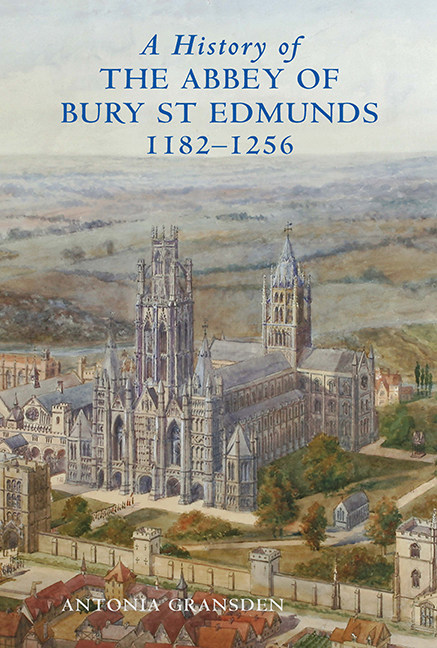Book contents
- Frontmatter
- Dedication
- Contents
- List of plates
- List of figures
- Preface
- Editorial Note
- Epigraph
- Acknowledgements
- Maps and plans (figures 1–9)
- Part I Samson of Tottington, Abbot 1182–1211
- PART II The Abbey 1212–1256
- 14 The vacancy, 1211–15, and election of Hugh of Northwold
- 15 The Abbots 1215–1256
- 16 Observance of the Rule of St Benedict
- 17 Learning
- 18 Books
- 19 Buildings
- 20 St Edmunds’ liberties and the Crown
- 21 Henry III and the cult of St Edmund
- APPENDICES
19 - Buildings
from PART II - The Abbey 1212–1256
Published online by Cambridge University Press: 29 April 2017
- Frontmatter
- Dedication
- Contents
- List of plates
- List of figures
- Preface
- Editorial Note
- Epigraph
- Acknowledgements
- Maps and plans (figures 1–9)
- Part I Samson of Tottington, Abbot 1182–1211
- PART II The Abbey 1212–1256
- 14 The vacancy, 1211–15, and election of Hugh of Northwold
- 15 The Abbots 1215–1256
- 16 Observance of the Rule of St Benedict
- 17 Learning
- 18 Books
- 19 Buildings
- 20 St Edmunds’ liberties and the Crown
- 21 Henry III and the cult of St Edmund
- APPENDICES
Summary
Of the seven monks who successively held the office of sacrist in the period 1215–57, only the second, Richard of Newport, appears among those benefactors whose acts and merits were recorded in the (now lost) martyrology and in the kitchener's register. He must have been a monk of some seniority already in 1213, since at that time he was subsacrist and took a leading part in opposition to the election of Hugh of Northwold to the abbacy. He was appointed sacrist in 1220 when his predecessor in that office, Richard of the Isle, became prior, and remained sacrist for about fifteen years, until sometime before 1234.
The entry for Richard of Newport in the kitchener's register is in the section for benefactors whose anniversaries were celebrated with ‘simple ringing of bells’ (‘simplici sonitu’). It reads as follows:
he destroyed the old chapter house and built a new one from the foundations; he bought the fishery at Icklingham at great cost; he had a great bell made for the main bell-tower which is called the ‘Newport’; he acquired 40s in annual rents for the recreation of the convent and the poor on the day of his anniversary, that is, two marks for the convent and one for the poor, according to the martyrology; he was a faithful custodian of the monastery's possessions in diverse offices and increased its lands and rents.
However, a marginal note apparently by the scribe of the text adds that the 40s rent acquired for ‘recreation’ comprised ‘20s annual rent in Manhall and 20s annual rent in Icklingham’. It concludes with the eulogy.
Richard of Newport seems to have inherited the zeal for the sacrist's office characteristic of Samson himself and of the sacrists during his rule. The information cited above shows that he combined concern for the buildings within the abbey precincts with care for those on its estates. There is more evidence about the new chapter-house. It replaced the early twelfth-century chapter-house constructed by Godfrey, sacrist under Abbot Robert II (1102–7), which was a short building with either an apsidal or a polygonal east end. It was probably too small for the community which by the thirteenth century had grown to seventy-five or so monks.
- Type
- Chapter
- Information
- A History of the Abbey of Bury St Edmunds, 1182–1256Samson of Tottington to Edmund of Walpole, pp. 229 - 235Publisher: Boydell & BrewerPrint publication year: 2007



